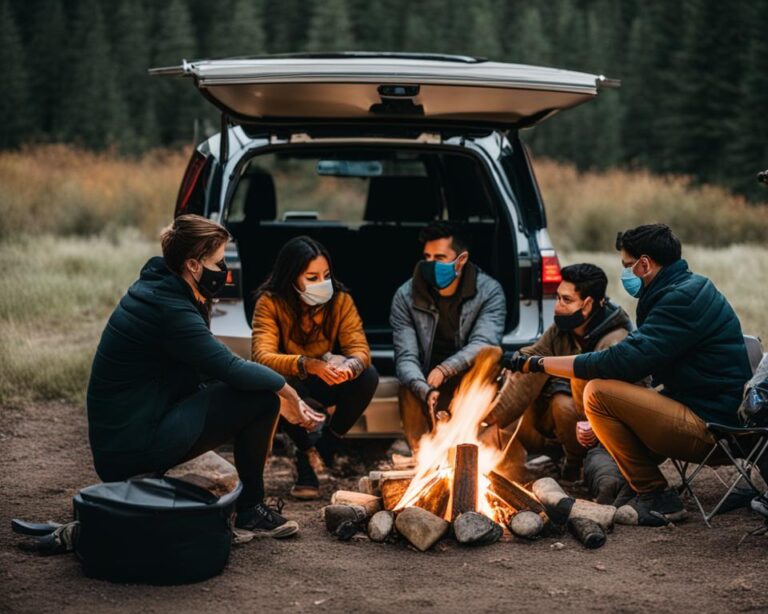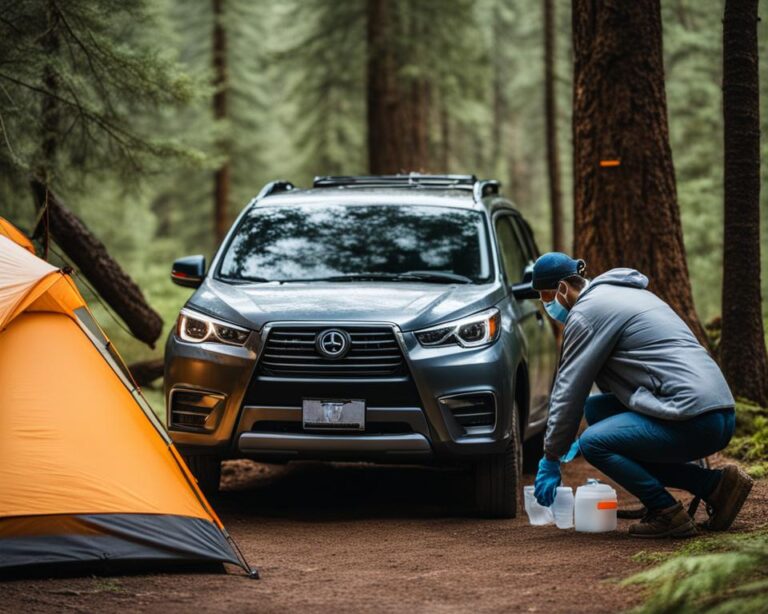Understanding How Long You Can Stay in a Car With a Running Engine
Staying in a car with a running engine can expose you to carbon monoxide, a dangerous gas from combustion. Carbon monoxide is colorless and odorless, posing severe health risks. Symptoms of poisoning include dizziness, confusion, and potentially life-threatening emergencies. Factors like temperature, ventilation, and personal health impact safe duration. High temperatures can cause heat-related illnesses in enclosed spaces. Adequate ventilation is vital to prevent harmful gas buildup. Vulnerable individuals, such as those with respiratory conditions, face higher risks. Be cautious of these dangers to safeguard your health and well-being.
Carbon Monoxide Poisoning Risk
Exposure to carbon monoxide while staying in a car with the engine running poses a significant risk of poisoning. Carbon monoxide is a colorless, odorless gas produced by the combustion of gasoline in the engine. When inhaled, it can rapidly build up in enclosed spaces such as a car interior, leading to potentially life-threatening medical emergencies. The exhaust fumes from the engine contain high levels of carbon monoxide, which can interfere with the body’s ability to absorb oxygen, causing symptoms like dizziness, confusion, headache, and even death in severe cases.
It is important to be aware of the dangers posed by carbon monoxide when spending time in a running vehicle. Even short periods of exposure to exhaust fumes can result in adverse health effects. Therefore, always ensure proper ventilation if you need to stay in a car with the engine running to prevent the accumulation of this toxic gas. Remember, your safety is paramount when it comes to avoiding carbon monoxide poisoning.
Factors Influencing Safe Duration
You need to take into account health and safety factors when determining how long it is safe to stay in a car with the engine running. Environmental impact is another vital aspect to take into consideration when deciding on a safe duration for staying in a vehicle with the engine on. Balancing these two points will help you make informed decisions regarding the length of time you can safely spend in a car with the engine running.
Health and Safety
Consider the impact of factors such as temperature, ventilation, and personal health on determining a safe duration for staying in a car with a running engine. Safety guidelines dictate that the duration should be minimized to reduce potential risks. High temperatures can lead to heat exhaustion or heatstroke, especially in enclosed spaces like cars. Adequate ventilation is vital to prevent a build-up of harmful gases like carbon monoxide, which can be fatal in high concentrations. Health considerations play a significant role in determining the safe duration. Individuals with respiratory conditions, the elderly, or children are more susceptible to the effects of poor air quality and extreme temperatures. It is recommended to keep the engine running time to a minimum and never leave vulnerable individuals unattended in a car with the engine running. Prioritize safety by being mindful of these factors to establish a safe environment within the vehicle.
Environmental Impact
Factors influencing the safe duration of staying in a car with a running engine include environmental impact considerations related to temperature, ventilation, and personal health. Environmental impact plays a vital role in determining how long it is safe to remain in a car with the engine running. Pollution control is essential to minimize the harmful effects of exhaust fumes on both individuals inside the vehicle and the surrounding environment. Sustainable practices, such as reducing unnecessary idling and maintaining proper ventilation, can help mitigate the environmental impact of idling vehicles. Conservation efforts also play a key role in minimizing the carbon footprint associated with idling cars. By being mindful of the environmental impact and taking proactive steps to reduce pollution, individuals can contribute to a healthier and more sustainable living environment. Remember, your actions can make a difference in pollution control and environmental conservation when it comes to staying in a car with a running engine.
Symptoms of Carbon Monoxide Poisoning
Symptoms of carbon monoxide poisoning typically manifest as headaches, dizziness, nausea, and confusion when exposed to high levels of the gas. These early signs are important indicators that you may be inhaling dangerous levels of carbon monoxide. If you experience these symptoms while inside a car with a running engine, it is essential to take immediate action to prevent further exposure.
In case you suspect carbon monoxide poisoning, the emergency procedures include turning off the engine, opening all windows to ventilate the car, and stepping outside to get fresh air. Remember, carbon monoxide is a colorless and odorless gas, making it imperceptible without specialized equipment. Therefore, being aware of these symptoms can aid in early detection and prevention of serious health issues.
It is crucial to prioritize your safety and well-being. If you or anyone else experiences these symptoms in a confined space with a running engine, take swift action to mitigate the risks associated with carbon monoxide exposure.
Importance of Ventilation
You must prioritize ventilation inside the car to guarantee excellent air quality. Proper ventilation is essential in reducing the risk of carbon monoxide buildup, which can be deadly in enclosed spaces. Additionally, good airflow helps prevent heat build-up, creating a safer environment for occupants.
Ventilation for Air Quality
Proper ventilation is essential when staying in a car with a running engine to maintain good air quality and prevent the buildup of harmful gases. Here are some key considerations for ventilation to guarantee a safe environment inside the vehicle:
- Air Circulation: Ensuring adequate air circulation inside the car helps in reducing the concentration of pollutants and replenishing oxygen levels.
- Window Ventilation: Opening windows slightly can greatly improve airflow and help in dissipating harmful gases such as carbon monoxide.
- Use of Air Vents: Utilize the car’s air vents to facilitate the movement of fresh air and the expulsion of stale air containing contaminants.
- Avoid Recirculating Air: When the engine is running, avoid using the recirculation mode on your car’s ventilation system to prevent trapping exhaust fumes inside the vehicle.
Risk of Carbon Monoxide
Effective ventilation in a car with a running engine is essential in minimizing the risk of carbon monoxide exposure and ensuring a safe environment for occupants. Carbon monoxide is a colorless, odorless gas produced by the combustion of gasoline in the engine. When inhaled in high concentrations, it can lead to carbon monoxide poisoning, which can be fatal. Preventing accidents related to carbon monoxide exposure requires proper ventilation to allow fresh air to circulate within the car and dilute any accumulated carbon monoxide. Monitoring exposure levels is critical in detecting any potential danger early on. Carbon monoxide detectors can be used to alert occupants if levels become hazardous. It is important to keep windows partially open or use the car’s ventilation system even in cold weather to prevent carbon monoxide buildup. By implementing these measures and staying vigilant about ventilation and exposure levels, occupants can greatly reduce the risk of carbon monoxide poisoning while inside a car with a running engine.
Preventing Heat Build-up
Adequate ventilation plays a crucial role in preventing heat build-up inside a car with a running engine. To guarantee your safety in such situations, consider the following cooling strategies and emergency protocols:
- Open Windows: Roll down at least two windows slightly to allow for cross ventilation, which helps regulate the temperature inside the vehicle.
- Use the AC Sparingly: If the car is stationary, running the air conditioning periodically can help manage heat levels. Be mindful of conserving fuel if the engine is running.
- Sunshades: Utilize sunshades on the windshield and windows to reduce the amount of heat entering the car.
- Emergency Exit Plan: Always have an emergency protocol in place in case the situation escalates. This plan should include exiting the vehicle promptly if heat becomes unbearable.
Safe Practices for Vehicle Use
Operating a vehicle safely involves adhering to recommended practices and guidelines to minimize risks and guarantee the well-being of all occupants. Two critical aspects to focus on are vehicle maintenance and temperature regulation. Proper vehicle maintenance is essential for safe operation. Regularly check and maintain your car’s engine, brakes, tires, lights, and fluids to make sure they are in top condition. This helps prevent breakdowns and ensures that all safety features are functioning correctly.
Temperature regulation is crucial for occupant comfort and health. Make sure your vehicle’s air conditioning system is in good working order, especially in hot weather. Never leave children or pets unattended in a hot car, as temperatures can rapidly rise to dangerous levels. In cold weather, ensure the heating system is functioning correctly to prevent hypothermia or frostbite.
Duration Limits for Different Vehicles
Maintaining safe practices while using a vehicle also involves understanding the duration limits for different types of vehicles to guarantee peak performance and safety. When considering how long you can stay in a car with a running engine, it’s important to take into account the vehicle capacity and temperature control to make sure a safe environment. Here are some key points to help you determine the duration limits for different vehicles:
- Vehicle Capacity: Each vehicle has a specified capacity for occupants, and exceeding this limit can impact air circulation and the overall safety inside the car.
- Temperature Control: The ability of a vehicle to regulate temperature varies based on make and model, affecting how long it can safely accommodate occupants without overheating or becoming too cold.
- Engine Size: The size of the engine can influence how long it can sustain running without causing overheating or other mechanical issues.
- Fuel Efficiency: Different vehicles have varying fuel consumption rates, which can affect how long the engine can run without refueling and the impact on air quality inside the vehicle.
Precautions for Using Car for Shelter
Utilize appropriate safety measures when utilizing your car as shelter to guarantee maximum protection and functionality. In emergency preparation scenarios, make sure your vehicle is well-maintained, with a full tank of gas and functioning heating or cooling systems. Regularly inspect the tires, brakes, and battery to prevent breakdowns when using your car as a shelter option. Safety measures should include having emergency supplies like blankets, non-perishable food, water, a flashlight, and a first aid kit readily available in your vehicle in case of unforeseen circumstances. Consider parking in safe locations to avoid exposure to environmental hazards or unwanted attention. Keep the windows slightly cracked for ventilation while maintaining security. It is essential to periodically start the engine to prevent the battery from draining and to circulate air within the vehicle. By prioritizing vehicle maintenance and implementing proper safety measures, you can effectively use your car as a shelter in emergency situations.
Emergency Situations and Response
In emergency situations, your immediate response must prioritize safety and efficiency to guarantee effective outcomes. When faced with a crisis while inside a car, following survival tips and having emergency preparedness can make a significant difference. Here are some essential points to take into account:
- Stay Calm and Assess the Situation: Keep a clear mind to evaluate the emergency and determine the best course of action.
- Ensure Vehicle Safety: Turn off the engine, roll down the windows slightly to prevent carbon monoxide build-up, and activate hazard lights for visibility.
- Plan Quick Exits: Identify all possible exits from the vehicle and have a plan in place for a rapid evacuation if needed.
- Communicate and Seek Help: Use a phone or any available communication device to contact emergency services or loved ones for assistance.
Understanding and Mitigating Risks of Carbon Monoxide Poisoning from Idling Vehicles
In summary, understanding the risks of carbon monoxide poisoning from idling vehicles is essential for safety. Factors such as ventilation, vehicle type, and duration of exposure play key roles in determining safe limits. By following recommended guidelines and practicing caution, individuals can minimize the risk of harmful effects. Remember to prioritize safety and take necessary precautions when using a vehicle for extended periods of time. Stay informed and stay safe.







